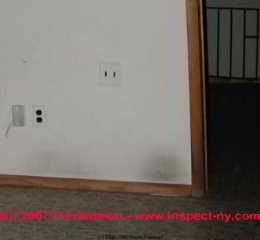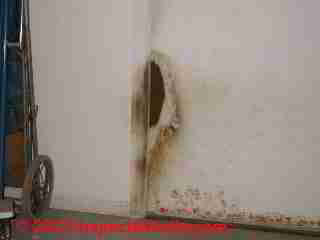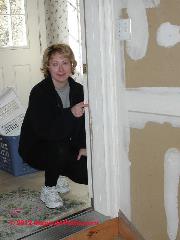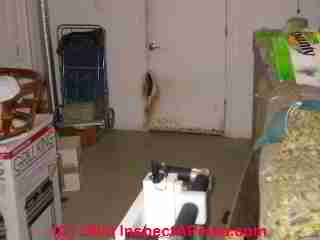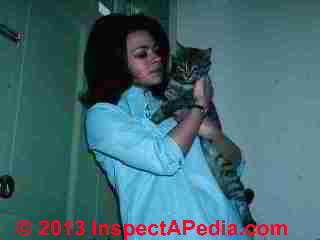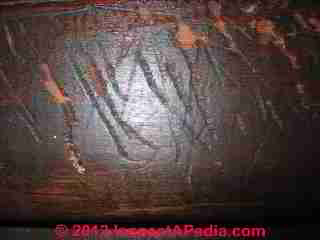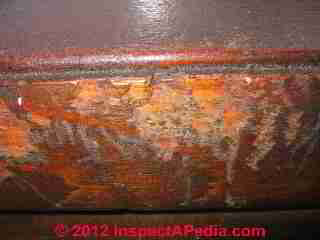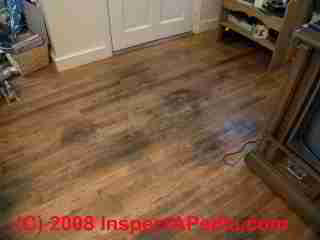 Pet Urine Stains & Scuff or Scratch Marks in buildings
Pet Urine Stains & Scuff or Scratch Marks in buildings
A
diagnostic guide to identifying & removing urine stains
& other marks
- POST a QUESTION or COMMENT about how to recognize pet stains in building walls & floors; how to remove pet urine stains & odors
Pet & other animal stain identification in buildings:
This article describes common indoor stains caused by animals and pets on floors and walls due to pet urine or simply from a pet frequently lying against or touching a building surface. We also describe a range of pet scrapes and scratches that can provide evidence about the building history of presence of pets.
These photographs also assist in determining when a building has previously housed pets or other animals even if none are currently present. We discuss the cause and cure of various types of pet stains, scrapes, scratches, and smells.
InspectAPedia tolerates no conflicts of interest. We have no relationship with advertisers, products, or services discussed at this website.
- Daniel Friedman, Publisher/Editor/Author - See WHO ARE WE?
How to recognize black stains on indoor walls and trim caused by pets, not mold
Article Contents
Pet (Dog) Stains on the Walls of a Building
With a little thought we can easily distinguish pet stains on drywall from thermal tracking by the stain pattern and location as well as other details such as the absence of a heat source, or the identification of a location where we'd expect a pet to rest.
Similarly we can identify black stains on walls where people's heads rested while sitting on furniture or in bed (see photo link just below).
Black marks on interior walls such as the black "mold suspect stains" shown on the white painted drywall in this photo might be just be where the dog lay on the floor against the wall (stain at floor level in this picture) or in this photographof black stains higher on a wall where people rested their heads in bed.
In buildings where pets are or have been housed, smudge marks on walls and at doors and door trim sometimes mistaken for thermal tracking.
Our page top photo is recognizable as animal urine stains on a floor . But what about those dark blob stains close to floor level on the wall and on the baseboard trim in our photo at above-left?
These dark wall stains are not mold, but these marks, along with others (scratches, urine stains) can tell us the history of pet occupancy in a building, information of use when investigating indoor air quality concerns, especially in spaces occupied by asthmatics or people with pet allergies.
Black marks on interior walls such as painted drywall might be just be where the dog [photo] lay on the floor against the wall (as shown in this photograph).
Provided the stains are due to simple contact between an animal and a building surface, the cures for dog or cat dirt marks on building walls or trim are simple cleaning or at most, re-painting.
Pet stains on Doors & Door Jambs
You may observe dark greasy stains on door jambs, and sometimes scratches and door trim damage due to pets, usually dogs or cats, where those animals frequently pass by, or stop to scratch themselves at those locations.
Our photo (at above left) it is is pretty obvious that "the dog did this" because of the wear where a pet, probably a dog, scratched fruitlessly at the door begging to be let out.
But more subtle dark stains may appear in these locations, from the same cause, but where dog and owner had better cooperation, as pointed-to by our client (photo at above).
[Click to enlarge any image at InspectAPedia.]
We welcome more thermal tracking, soot tracking, air bypass leaks, and similar photos of indoor stains as well as text suggestions to expand this detail and would be glad to credit contributors.
Usually soot marks, thermal bridging, or thermal tracking stains appear, if at all, in the building interior locations discussed in the remaining sections of this article.
Pet Urine Stains on Building Walls or Carpets
Perhaps the most griped about indoor stain where pets are or were present is cat or dog pee stains on carpeting.
When a dog, cat, (or in some reported cases humans) has urinated on carpeting we recommend that the wall to wall carpet and carpet padding be replaced. Virtually no cleaning product will be capable of removing all of the molecules that invite your pet to pee (or poop) there again.
Even when carpet cleaners and sanitizers are used and the room smells great and there is no visible stain, the presence of pet pee in carpet backing or carpet padding or even in subflooring below will invite a new visit to this public pet toilet.
When you remove carpeting and before replacing it, check the condition of the floor below, and if the pee spot was close to building walls, check for pee-soaked drywall or trim boards too.
The flooring or subflooring below the urinated-on carpet needs to be inspected for stains and penetration of urine as well.
More About Killing Pet Odors vs Removing Pet Urine Odors
There are lots of reasons that animals urinate in buildings, and pet owners know most of them: no access to a litter box, dirty litter box, dog shut indoors too long, dog or cat marking territory, fear, etc.
And as we introduced just above, most pet lovers know well that once-peed-on is again-peed-on in many cases.
Back in the 1970's in our first apartment Wappingers Falls one of our two cats peed and pooped on Harriet's pillow.
We were not sure which cat chose Harriet for this special attention. But whoever it was, the damn cat did it again and again. Harriet and Hobbit, one of the possible culprits are shown at left. Finally Harriet (the human in the photo at left) gave me this ultimatum:
Either THEY GO or I GO!
My mother later opined that that was when I made a big mistake. Just sayin'. A pet shut into a room and abandoned may have no choice about where it relieves itself.
Because urine leaves an odor in wood surfaces that is difficult to remove, once an area has been used as a cat or dog toilet, animals are likely to return to that spot to pee on it again. It's trivial to throw out a peed-on pillow, but what do we do about peed-on wood floors?
While special pet deodorizers and cleaners are available to clean and remove pet odors, we find that often the animals will continue to return to the scene of their accident or crime. If the amount of urine was very small, an ounce, one event, covering just a few square inches, it may be possible to clean and seal the subfloor using a lacquer primer/sealer, clear shellac, or another appropriate re-finishing coating.
See ANIMAL or URINE ODOR REMOVAL, and
also URINE ODOR REMOVAL in CLOTHING for detailed advice on how to find and remove pet and other animal or human odors and smells in buildings or from carpets and clothing.
Pet Urine Stains on Building Floors - How to Recognize & Remove Stains in Wood Floors
Often when an animal has urinated one or more times on a carpeted floor, later removal of the carpeting will disclose dark stains in the wood flooring of a finished floor.
Our photo (left) shows severe urine staining on a hardwood floor of a bedroom outside of a bath. The owner was unaware of the stains until the carpeting was removed.
The white colors in the stained area demonstrate the futility of attempting to remove the animal stains by bleach.
If stains penetrate only a millimeter of wood it might be possible to sand and re-finish the floor, or to use a combination of sanding, bleaching, and re-staining of the finish floor as we describe just below.
Reader J.W. comments on using hydrogen peroxide to remove pet urine stains from wood flooring: :
If you have pet urine on blond wood or soft light wood, then you can use hydrogen peroxide on the wood by applying several applications--just rub it in with a cloth or a brand new dry sponge and let dry then repeat often until your wood is light again. I had this problem when i pulled up a carpet that came with the house when i bought it 10 yrs ago & found dark pet stains on the soft yellow pine wood & realized it was pet urine.
We also have removed small areas of stains in wood flooring by working meticulously with diluted bleach and a cotton swab, applying bleach, then washing it off, in several cycles until the stained area of the wood reached a color closely matching the original wood flooring out of the stain.
Watch out: don't over-bleach flooring when trying to remove stains or you'll end up with a too-light area of wood. If you make this mistake, working carefully with wood stain products such as those made by MinWax you may be able to return the over-bleached wood floor area back to the necessary hue. Hydrogen peroxide is less risky in this regard.
But often we find that the urine stains have penetrated the wood so deeply that flooring replacement is about the only option if the occupants don't want to live with these stains.
First Aid for Pet Peed-on Carpets & Hardwood Floors
Reader Question: can we see dog pee or poop stains when dry? How do I protect the floors from damage? What will I find under the rug?
I had a few questions about stains on rugs and hard wood floors if you could help me. Can pet stains from a dog be seen when they are dried? Or is there a special way to see them.
Also if pains [sic] stain are on a run and there is a padding underneath the rug will it mess the hard wood floors up? If so how long will it take to mess them up?
Also if the hardwood floor gets messed up from pet stains can it be sanded and refinished?
When a rug is pulled up underneath what would be like dark yellowish stain on the bottom of the rug? - B.M. 01/29/2014
Reply: suggestions for finding animal or other urine stains on carpets & other building surfaces
In the article above and in companion articles listed at the end (More Reading) we discuss both obviously visible pet urine (or worse) stains in buildings, carpets, floors, walls, and
at UV LIGHT BLACK LIGHT USES we discuss using a black light that can help spot urine stained materials even after drying and where there is no obvious visible mark.
You might also want to check out
The ugly black blotches shown in our photo penetrate rather deeply into this oak hardwood floor. Previously wall-to-wall carpeting had been peed-on repeatedly but the carpet, left in place, hid more difficult damage that was developing in the floor itself.
Deep stains like these may not be removed by surface-sanding, though I have had some success with sanding to remove the top coating of floor sealer, meticulous bleaching, followed by a re-staining and re-finishing of the entire floor.
It may be possible to clean and deodorize carpets but in my experience unless we also deliberately odorize the carpet with something the animal's nose and the animal itself hate (like an ammonia smell) the dog or cat is likely to pee or poop in the same spot again.
It is more difficult to deodorize padding. I would prefer to remove both carpet and padding if peed-on, but understanding that's often very costly and people wish to avoid that expense, one might try carpet cleaning and under-padding replacement.
In my experience animal urine that soaks through carpet and padding and left alone will ruin a hardwood floor by making dark stains that go rather deep into the wood.
A first aid routine that minimizes risk of that damage includes these steps:
- Pull back both carpeting and padding over the flooring as soon as the urine stain is found or even suspected.
- Clean the hardwood floor surface below the pet-peed carpet and padding.
- Put down six-mil poly plastic (temporarily) extending a couple of feet past the peed area so that you can put the carpet back down without pee or carpet cleaner bleeding through to (and damaging) the floor below.
- Then try a rug shampooer. There are quite a few cleaners sold claiming to remove pet odors; some of the more expensive and maybe more effective products are sold through veterinarians and pet supply outlets.
- These articles also contain advice on urine odor removal
- If the padding is also smelly, I'd cut out the smelly area of padding and piece in a replacement section under the cleaned, dried carpeting.
Reader Question: odd stains on carpet may be traced to old pet urine spots
9 Oct 2014 Brennan said:
Have you ever seen this in carpet in the middle of a room (not near the baseboards). I received a moisture meter to check some ceiling stains to see if they were active or inactive after the former owner replaced the roof. I was using the moisture meter to check the basement- all surfaces. I found some areas in the basement carpet where the moisture meter was high but dry to the touch. I run a humidifier in that room and it doesn't work very hard to maintain 45-50 rh%
It has a 'line' type stain. A bit darkened (carpet is grey, so this is darkish grey), but not like the other areas where there is actual infiltration soiling (I have seen it is one room near the baseboards but is completely dry). My home is old, so of course it has air leaks.
The former owners had a couch over this area, so I thought it was due to that. Adjacent staining is yellow coloring and also shows moisture in the meter. So moisture and a line/ghosting in carpet. The carpet is gross anyway, so I thought about peeling it back to see if there is a crack in the slab (60+ yr old house).
A contractor friend, without seeing it, said it was radon gas escaping. That seemed like a stretch, since Radon is colorless. I think though, perhaps he meant, air is feeding through the crack and depositing soil on the carpet.
If I do find a crack- should is seal it with concrete/caulk and re-carpet and be vigilant about dehumidification?
This question was originally posted
at THERMAL TRACKING BRIDGING GHOSTING
Reply: moisture meters versus carpet stains
Brennan
A couple of points to consider:
Most moisture meters, if we exclude thermal imaging, rely on measuring differences in electrical resistance to detect moisture. But other contaminants or materials can also decrease resistance in an area of building material. So not every reading variation is necessarily truly detecting moisture. Some attention, particularly looking for possible moisture sources, are key.
Both pin type moisture meters (Delmhorst for example) and electronic moisture meters (such as some Tramex meters) can be fooled by metal nearby: pipes, foil faced insulation, wiring.
Second: no moisture meter, nor thermal imaging device, can detect old leaks that have since dried, even though the leak might have initiated a building problem with rot, insect damage, or mold contamination.
This is why we argue that reliance on meters and imaging alone for water or mold detection are unreliable. But the instruments are indeed useful, in thoghtful hands. And neat too.
See MOISTURE METER STUDY and
See THERMAL IMAGING, THERMOGRAPHY
Reader follow-up: old urine stains leave salts, are hygroscopic, and might be picked up by a moisture meter
Thanks for your comment. One thought (using my science background) was that the moisture meter gives a high reading on what looks like an old dog urine stain (former owner had dog). I had the thought that these left over salts and ions from the urine might act as a weak conductor and activate the moisture meter.
On the internet, it seems that carpet companies use moisture meters to find hidden pet stains, because the salt from the urine can draw moisture from the air (or even just the natural evaporation of the concrete slab). So, thanks for your help. I tend to over-think things. I agree, it is a neat tool.
Examples of Scratches Indicating Animal Presence in Buildings
Noticing scratches or tears on floors, trim, even walls and furnishings can indicate a previous presence of cats, dogs, or other pets or animals in a building.
For example notice the pet scratch marks on the floor trim in our photos just below.
See ANIMAL DAMAGE to BUILDINGS - for more examples of chewing, biting, scratching, or other animal or pet damage to or in buildings.
...
Reader Comments, Questions & Answers About The Article Above
Below you will find questions and answers previously posted on this page at its page bottom reader comment box.
Reader Q&A - also see RECOMMENDED ARTICLES & FAQs
On 2019-10-17 Jenny said: my cats are peeing everywhere
Jenny said:
Great post, you guys! One of my 2 cats (both neutered males) had taken to painting all of my walls, furniture, and anything else he could reach.
I was horrified when I got a UV light. He never did that in all of the 9 years I've had him and didn't when I got him a buddy (they love each other and did so right away) but when a strange black cat started showing up outside both of my cats went nuts and the older one (9) started his wall painting, as well as the curtains out in the kitty room. I couldn't keep up with it.
My cats are indoor cats so it's not like the stray is actually going to get in here but they both hate him (and he is weird...my neighbor's cats hate him too).
I've tried cleaning with a pet urine enzyme and then spraying some "No More Spraying" but that hasn't worked.
He's a sneaky little bugger too; he waits until he thinks I'm not looking and then does it. He's learned that the minute I see him backing his butt up to something he gets yelled at.
It wasn't until I found "Cat Spraying No More" that I was able to finally get rid of this tiresome behavior. Now my house doesn't smell like a litter box anymore :)
Here's a link the their site if you're interested in checking it out, I highly recommend this: nomorecatpeedotcom
Jenny
On 2019-05-03 - by (mod) -
Try posting a photo - one per comment -
On 2019-05-03 6 by Dawn
My outside entry way has black stains on the concrete. At first it was a small circular spot, maybe 2-3 inches in diameter. The latest stain looks like the imprint of an animal (cat?) with a bushy tail that was relaxing in my entryway. I have no idea what it could be but the stains aren't going away.
On 2017-05-23 - by (mod) - test the stains on the wall to see who did it?
Yes, You could collect swab samples From the wall surface and have them processed by a forensic lab
That can do DNA analysis. However in my opinion that it's not likely to become justified and I think it would make more sense to look at the location and pattern of the stain, as usually that would be sufficient to determineWho or what made those marks. I'll give an example.
Consider that a cat or dog leaning against a wall will leave marks at a significantly different height from a human being, even a human sitting on the floor leaning against the wall.
Also the stain location can be correlated with where a pet or human would obviously lean, rub, or pass by.
At STAIN DIAGNOSIS on BUILDING INTERIORS you'll see a photo of just such dark stains on a white-painted drywall surface along with our comments.
See Black stains from animals for details about pet stains on building floors (urine) and for black
or other pet stains on walls see Pet Stains on Walls for diagnosing stains such as the black marks in our photo .
You are also welcome to use the InspectApedia.com search box just above to search for such phrases as
"PET STAINS" or
"ANIMAL STAINS" to see more articles, photos, examples.
On 2017-05-23 by Adrian
Is their a way to test the stains on the wall to see who did it? Meaning if was caused by a human instead of a pet?
On 2016-03-12 - by (mod) - the bird turned the ceiling yellow?
Kristy, The bird may not be to blame, but if a stain is appearing in your ceiling I'd think about looking for a leak into that space from above, or an indoor air contaminant source from below.
On 2016-03-11 Kirsty
My tenant has a bird in a cage and the ceiling above has turned yellow. Do you think this is coincidental or caused by the bird. The distance from cage to ceiling is quite significant.
On 2015-11-06 0 - by (mod) - best way to remove dog urine stains
Clean, disinfect, and when dry, see if the surfaces need to be sanded and re-finished as discussed in this article.
On 2015-11-06 by Homebuyer
What's the best way to remove dog urine stains from subflooring (plywood) and concrete - meaning the concrete slab that was under tile.
On 2015-06-22 by Jan S
How can I remove stains made be a large dog to the exterior light brick wall of our house. The stains are in an area where the dog sleeps and lounges.
Question: how do you get rid of these pet stains - my dog peed
(May 28, 2012) Cherie said:
How do you get rid of stains like these, my dog made black pee stains and we rent the place please help!
Reply:
Cherie,
I am sorry to say that in my experience those black pee stains are almost impossible to remove from a wood floor. The urine that has soaked into the wood stains as deeply as it has soaked-in.
If the stains were just at the surface, careful use of household cleaners or even bleach can restore the floor enough that with some stain it can be returned to its original color.
Deeper stains, as we usually find is the case, can on occasion be removed by deep sanding, if the floor has enough thickness of wood to permit sanding and refinishing - a costly process.
Still deeper stains - the fix is to replace the flooring, or re-cover it with a new floor.
Sorry but deep stains are very often the case, especially if the urine was through carpeting onto a wood floor below, as the carpet holds urine in place for a longer time.
It is for this reason that no reasonable security deposit will be big enough to cover the possible costs of pet urine damage to a building. The landlord would have had to collect a deposit that, in addition to other protections, could cover floor replacement or re-finishing.
Try cleaning and dilute bleaching to see if you can remove or whiten the stains. Work first on a small stain area in a less obtrusive spot to practice. Apply bleach, remove it promptly, reapply, in stages so that you don't over-bleach the flooring making it too white.
If that doesn't work, the more costly approaches above are about all that's left.
Question: we're worried that a dark stain on the floor is mold but could it be from dogs?
(June 30, 2012) Merrell said:
We recently rented a home, and noticed a dark stain in the room we were setting up as our daughter's bedroom. We are worried that it's water/ mold stain, however the owners insist that its been there for 8 years and has not changed at all since then. What are some ways to tell the difference between an animal stain (they had 2 dogs) and potential foundation leak/ mold stains?
We are being told to come out of pocket for an inspection if we are really concerned. We are definitely concerned but before hiring someone, we'd like your suggestions on how to best determine what this stain is. Thank you!
Forgot to mention, this stain is appearing on wood flooring surface. Thank you!
Reply:
Merrill the most immediate and unambiguous way to distinguish between pet stains and stains on a wood floor due to a foundation leak (and related mold) would be by visual inspection to trace the stains to and through actual building ocmponents. For example the stains shown in the photos above on this page do not connect to any nearby plumbing nor to an exterior wall. In other words, follow the water path.
Also, "mold stains" that are due to recent leakage would likely be accompanied by mold. If you cannot wipe any material whatsoever off of the surface, that is, if the surface was previously cleaned or never had surface debris in the first place, but the stain is imbedded into the wood, it could be a pet urine or feces stain.
If that stain connects to an area of historic or recurrent water leaks, and if the area was previously moldy but the mold was removed, the black stain that remains in wood is generally of cosmetic import only. Finally, if you believe that there was a history of building or plumbing leaks, following the path of water from those leaks will show you where else to explore for possible hidden problems. For example one might make a small exploratory test cut into a wall cavity in the area of most-suspect wetting to evaluate the condition of the cavity space.
See MOLD APPEARANCE - WHAT MOLD LOOKS LIKE
Question:
(Nov 1, 2014) pat baum said:
headaches dizzy metallic taste from cat urine fumes throughout house.cleaned areas where I know cats go. windows open. heap air cleaner on. did not work. I cannot leave house because I have no where to go. what can I do? HELP
Reply:
Pat, call your doctor for medical advice - first.
No air cleaner will remove the source of odors or contaminants. That needs to be found and cleaned or removed.
See URINE ODOR SOURCE DETECTION in the master index found at CONTINUE READING links above.
Question: dog peed through rug onto pine floor
(Dec 3, 2014) rain said:
I have yellow pine floor with 3 coats varnish. A Persian rug on top, dog peed, floor now has dark yellow pee circles. how do I get rid of the dark yellow circle?
Reply:
Rain you'll probably have to re-finish the flooring area if simple surface cleaning with a mild detergent or vinegar doesn't remove the marks.
...
Continue reading at ANIMAL or URINE ODOR REMOVAL or select a topic from the closely-related articles below, or see the complete ARTICLE INDEX.
Or see these
Recommended Articles
- ANIMAL ALLERGENS / PET DANDER
- ANIMAL DAMAGE to BUILDINGS - home
- ANIMAL or URINE ODOR REMOVAL
- ANIMAL STAINS & MARKS in BUILDINGS
- CARPET STAIN DIAGNOSIS - home
- LAMINATE FLOOR DAMAGE REPAIR
- STAIN DIAGNOSIS on BUILDING INTERIORS - home
Suggested citation for this web page
ANIMAL STAINS & MARKS in BUILDINGS at InspectApedia.com - online encyclopedia of building & environmental inspection, testing, diagnosis, repair, & problem prevention advice.
Or see this
INDEX to RELATED ARTICLES: ARTICLE INDEX to BUILDING STAINS
Or use the SEARCH BOX found below to Ask a Question or Search InspectApedia
Or see
INDEX to RELATED ARTICLES: ARTICLE INDEX to ANIMAL PESTS, ALLERGENS, HAZARDS
Or use the SEARCH BOX found below to Ask a Question or Search InspectApedia
Ask a Question or Search InspectApedia
Try the search box just below, or if you prefer, post a question or comment in the Comments box below and we will respond promptly.
Search the InspectApedia website
Note: appearance of your Comment below may be delayed: if your comment contains an image, photograph, web link, or text that looks to the software as if it might be a web link, your posting will appear after it has been approved by a moderator. Apologies for the delay.
Only one image can be added per comment but you can post as many comments, and therefore images, as you like.
You will not receive a notification when a response to your question has been posted.
Please bookmark this page to make it easy for you to check back for our response.
IF above you see "Comment Form is loading comments..." then COMMENT BOX - countable.ca / bawkbox.com IS NOT WORKING.
In any case you are welcome to send an email directly to us at InspectApedia.com at editor@inspectApedia.com
We'll reply to you directly. Please help us help you by noting, in your email, the URL of the InspectApedia page where you wanted to comment.
Citations & References
In addition to any citations in the article above, a full list is available on request.
- Thanks to reader J.W. for discussing possible methods to bleach out pet urine stains in wood flooring, January 2011.
- Our recommended books about building & mechanical systems design, inspection, problem diagnosis, and repair, and about indoor environment and IAQ testing, diagnosis, and cleanup are at the InspectAPedia Bookstore. Also see our Book Reviews - InspectAPedia.
- In addition to citations & references found in this article, see the research citations given at the end of the related articles found at our suggested
CONTINUE READING or RECOMMENDED ARTICLES.
- Carson, Dunlop & Associates Ltd., 120 Carlton Street Suite 407, Toronto ON M5A 4K2. Tel: (416) 964-9415 1-800-268-7070 Email: info@carsondunlop.com. Alan Carson is a past president of ASHI, the American Society of Home Inspectors.
Thanks to Alan Carson and Bob Dunlop, for permission for InspectAPedia to use text excerpts from The HOME REFERENCE BOOK - the Encyclopedia of Homes and to use illustrations from The ILLUSTRATED HOME .
Carson Dunlop Associates provides extensive home inspection education and report writing material. In gratitude we provide links to tsome Carson Dunlop Associates products and services.


